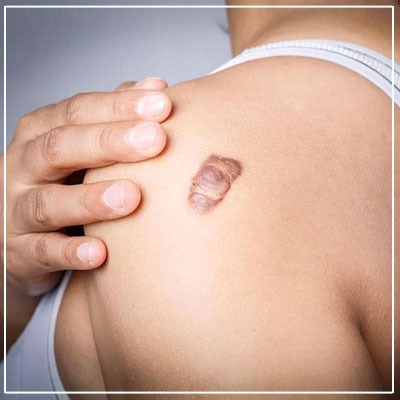Keloid Scar Treatment
What is a Keloid?
When we have a skin injury, our bodies go into healing mode and build scar tissue over the wound. This scar tissue, which is formed of fibrous tissue, protects the wound and allows it to recover. However, in rare situations, the body may create an excessive amount of scar tissue. Excess scar tissue, which is mostly collagen, may result in smooth, hard growths known as Keloids. They are typically not hazardous to the patient’s health. However, the patient may feel uneasy as a result of the aesthetic or cosmetic issues that it causes.
These Keloids often begin to develop in the shape of a claw, eventually becoming larger than the injury itself. The chest, shoulders, earlobes, and upper back are the most often affected areas of the body, however they may affect any portion of the body.

What are the symptoms of keloid?
The following symptoms are common at the location of the skin injury:
- A lumpy or rigid structure on the skin’s surface.
- It expands in conjunction with the scar tissue.
- itching on the skin
- The affected site becomes flesh-colored, pink, or red.
- Friction with clothing or other objects may produce pain, irritation, or soreness.
- In rare circumstances, movement may be restricted.
What are the causes of keloid?
Keloids are often caused by skin injuries such as:
- Scars from acne
- Burns
- Vaccination sites
- Hereditary
- Scars from chickenpox
- Ear piercings
- Incision sites after procedures
What should a patient do in this situation?
It is advised to visit a dermatologist if you notice keloids or other similar growths on your skin. It is nothing to be concerned about since keloids are not hazardous and are typically harmless. In certain circumstances, keloids may simply decrease and flatten over time, even if no therapy is used.However, if the development is uncontrolled, it might be an indication of skin cancer, therefore early identification is important.
What therapy alternatives will be available to treat keloid?
Procedure & Treatment
Cortisone Injections (Intralesional Steroids): These are painless and safe. Injections are typically administered once every four to eight weeks into the keloids) and usually help flatten keloids; however, steroid injections may also make the flattened keloid redder by stimulating the formation of additional superficial blood vessels.
Surgery: After removing the keloid by surgical excision, by injecting steroids or putting pressure dressings on the wound site for months may be indicated. Radiation has also been employed following surgical excision.
Silicone Sheets: This entails keeping a sheet of silicone gel over the affected region for months at a time and may reduce keloid formation.
Cryotherapy: While freezing keloids with liquid nitrogen may flatten them, it often darkens or lightens the treatment site.
Interferon Therapy: Interferons are proteins generated by the body’s immune systems that aid in the battle against viruses, bacteria, and other threats. In recent trials, interferon injections have shown promise in lowering the size of keloids. Many studies are being conducted utilizing a variation of this approach, which involves the use of topical imiquimod, which boosts the body’s production of interferon.
Fluorouracil: Injections of this chemotherapeutic drug, alone or in combination with steroids, have also been used to treat keloids.
Laser Therapy: Laser therapy is recommended by doctors to lessen redness and discolouration in older scars. Laser treatment is also used to treat acne scars and to make stretch marks less visible. With the laser’s energy, the blood vessels in scar tissue will weaken and finally disintegrate. Because blood vessels generate redness and coloring in scars, this allows the keloid scar to diminish.
For more information & consultation on Keloid, visit VIVA Aesthetic Clinic at Opera House or contact us on 022 3573 1556 | 93245 89084 or simply fill in your name and number & one of our team member will get in touch with you soon. Our team of experts along with Dr. Deepam Shah, MD. DNB. FAM – Dermatologist, Cosmetologist & Hair Transplant Surgeon, will help you out in understanding your problem and guide you through every stage of your treatment.
At Viva Aesthetic Clinic, we offer Hair transplant, Aesthetic treatments and skin care with the help of latest technology, world class procedures and a dedicated team led by Dr.Deepam Shah . We are your one-stop clinic in India for comprehensive Hair Restoration, cosmetic laser treatment and skincare solutions.
